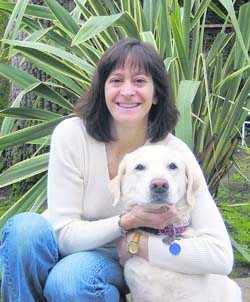| | Published March 4th, 2009
| NOTES ABOUT VETERINARY SCIENCE
| | By Mona S. Miller, DVM |  | | Dr. Mona S. Miller lives in Lafayette with her 4 year old son, yellow Labrador Retriever and grey cat. She has worked at Four Seasons Animal Hospital in Lafayette since moving here in 2001. She attended Cal as an undergrad, and received her DVM from U.C. Davis. She can be reached at Four Seasons,
938-7700, or by email to
MonaSDVM@aol.com.
|
This column was inspired by a recent conversation with a friend, during which I was asked, "If I were in your office, would I call you 'doctor'?" The answer is "yes" - as a small animal general practitioner in Lamorinda, I provide preventive health care, general surgery and treat disease in a variety of species including dogs, cats, birds, reptiles, rabbits and rodents. Veterinarians are licensed doctors, and the field has expanded in the past 50 years to include specialists as well as licensed nurses. The future holds potential for sub-specialization in disciplines such as small animal cancer surgery and equine sports medicine/lameness.
 Veterinary science is the application of medical, diagnostic and therapeutic principles to a variety of animals, such as companion and domestic, exotic and wildlife, and production animals. Links to humans are found in issues of zoonoses (diseases that can be passed from animals to humans) and infectious disease surveillance and control. Veterinarians can find jobs in private practice, biomedical research institutes, academia, food production, government and military services.
Veterinary science is the application of medical, diagnostic and therapeutic principles to a variety of animals, such as companion and domestic, exotic and wildlife, and production animals. Links to humans are found in issues of zoonoses (diseases that can be passed from animals to humans) and infectious disease surveillance and control. Veterinarians can find jobs in private practice, biomedical research institutes, academia, food production, government and military services.
 To become a Doctor of Veterinary Medicine, one must have completed a four-year graduate program at a veterinary school (usually after obtaining a four-year Bachelor of science or art degree), and hold a state license to practice. Licensing requirements vary from state to state, but generally consist of both national and state board examinations. Most veterinarians in general practice enter the workforce at this point. Some do a one-year internship program in general medicine and surgery, usually the first year after vet school, in order to gain experience in intensive and/or high volume hospitals.
To become a Doctor of Veterinary Medicine, one must have completed a four-year graduate program at a veterinary school (usually after obtaining a four-year Bachelor of science or art degree), and hold a state license to practice. Licensing requirements vary from state to state, but generally consist of both national and state board examinations. Most veterinarians in general practice enter the workforce at this point. Some do a one-year internship program in general medicine and surgery, usually the first year after vet school, in order to gain experience in intensive and/or high volume hospitals.
 Specialization began in 1951 with the development of the College of Vet Pathologists. A specialist has completed a two to four-year residency program in the specific field, and has passed a set of rigorous examinations. Today, the American Veterinary Medical Association recognizes 20 specialty fields, including toxicology, laboratory animal medicine, poultry, reproduction, anesthesia, behavior, clinical pharmacology, dermatology, emergency and critical care, internal medicine, microbiology, nutrition, ophthalmology, preventive medicine, radiology, surgery, zoological medicine and dentistry.
Specialization began in 1951 with the development of the College of Vet Pathologists. A specialist has completed a two to four-year residency program in the specific field, and has passed a set of rigorous examinations. Today, the American Veterinary Medical Association recognizes 20 specialty fields, including toxicology, laboratory animal medicine, poultry, reproduction, anesthesia, behavior, clinical pharmacology, dermatology, emergency and critical care, internal medicine, microbiology, nutrition, ophthalmology, preventive medicine, radiology, surgery, zoological medicine and dentistry.
 Registered Veterinary Technicians are valued as professional nurses. To accomplish this, the nurse must complete general education requirements equivalent to a two-year Associates degree and then a two-year program to achieve an Associates degree in Veterinary Technology, and pass a licensing examination.
Registered Veterinary Technicians are valued as professional nurses. To accomplish this, the nurse must complete general education requirements equivalent to a two-year Associates degree and then a two-year program to achieve an Associates degree in Veterinary Technology, and pass a licensing examination.
 There are 28 veterinary schools in the United States. The first American school was the Veterinary College of Philadelphia, which operated from 1852-1866. There are now two vet schools in California. The School of Vet Med at University of California, Davis is celebrating its 60th anniversary this year. In 1998, the College of Vet Med at Western University of Health Sciences in Pomona became the newest veterinary school in America in over 20 years, and graduated its first class in 2007.
There are 28 veterinary schools in the United States. The first American school was the Veterinary College of Philadelphia, which operated from 1852-1866. There are now two vet schools in California. The School of Vet Med at University of California, Davis is celebrating its 60th anniversary this year. In 1998, the College of Vet Med at Western University of Health Sciences in Pomona became the newest veterinary school in America in over 20 years, and graduated its first class in 2007.

|
| | | | | | | | Advertisement | | |
| | | | | | Comments | | | | | | | | | | | | | | | Subscribe / Unsubscribe | | | | | |
| | | | | |  | | |
| | |  | | |
| | | | | |

